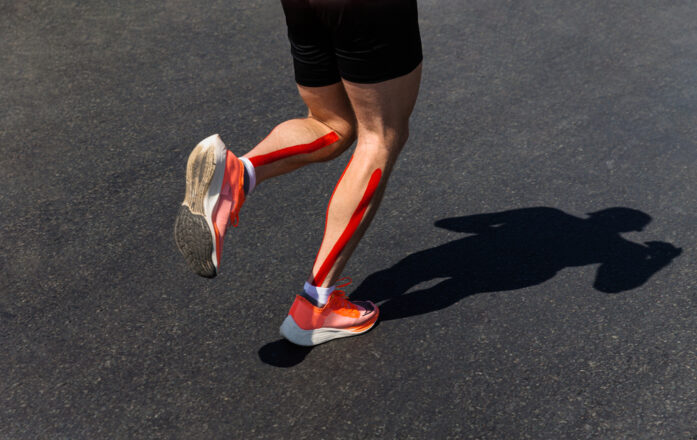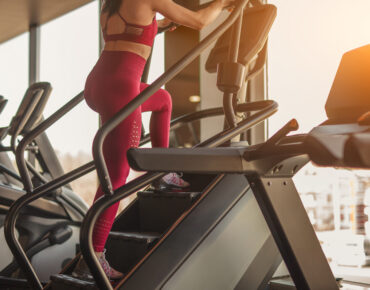Do you know what makes the difference between well-developed calves on the one side and skinny legs or tree trunks for legs on the other? It’s not only genes. It’s how and how often you train with calf exercises.
Walking doesn’t make your calves bigger, that’s only a myth, though it can burn fat in the calf area. If you’re wondering how to increase your calf size or slim it down, you need to add strength and resistance training to your workouts.
The best exercises for calves are not too difficult. If you don’t have a gym membership, don’t worry – there are plenty of no-equipment home workouts.
In this post, we’ll share some lower-body strength training tips for your leg-day workouts.
But first…
In This Article:
Why Is It Important to Stretch Your Calves?
The calf is not just one muscle but a collection of muscles, including the gastrocnemius, which rounds up the calf, and the soleus running down your leg. Effective calf muscle exercises will target both muscles.
Working out and stretching calves is not just a question of appearance. Strong calves improve ankle mobility and stability and could help reduce the risk for Achilles tendonitis, shin splints, and other injuries common among runners.
Stretching your calves is also important if you have tight calf muscles. These can cause fatigue in the lower legs, pain, and difficulties flexing toes, all of which can decrease your running performance.
Best Calf Exercises and Workouts
The mobility of the ankle joint impacts calf workouts. The best calf exercises take advantage of correct foot positioning to fully train your calf muscles.
Hikers often have well-developed calves because they’re working their muscles from variable angles. So the best way of building strong, three-dimensional calves is by incorporating a variety of exercises.
If you’re wondering how to get bigger calves by bulking up muscle or how to get smaller calves by shedding fat, the following exercises have you covered.
So, what are some of the best calf exercises?
Jumping jacks
Let’s start with one of the classic body weight calf exercises – and one of the easiest.
Difficulty: All levels
Reps: 20 to 25
Sets: 3 to 5
Recovery time: 60 seconds between sets
How to do it:
- Stand with your arms at your side and feet together.
- Jump and spread your legs as you clap your hands above your head.
- Jump and return your feet and hands to the initial position.
Seal jumps
Great calf exercises without equipment often include seal jumps. These are similar to jumping jacks.
Difficulty: All levels
Reps: 20 to 25
Sets: 3 to 5
Recovery time: 60 seconds between sets
How to do it:
- Stand in the jumping jack position.
- Jump with your feet out and extend your arms out to your sides.
- Jump back, clapping your hands in front of you.
Single-leg calf raise
Calf raise exercises are easy to get started with, especially for beginners.
Difficulty: All levels
Reps: 15 to 20
Sets: 1 to 5 for each leg
Recovery time: 45 seconds between sets
How to do it:
- Stand on a firm, level surface with your feet beneath your shoulders.
- Raise one foot and bend your leg at the knee to a 90-degree angle.
- Press through the ball of your other foot to lift your heel off the ground.
- When you reach the top of the movement, squeeze the calf muscle.
Standing calf raises
Standing calf raises are effective slimming exercises. The simple version of this exercise doesn’t require any special equipment. If you do it at the gym, you can use a calf exercise machine.
Difficulty: All levels
Reps: 10 to 20
Sets: 3 to 5
Recovery time: 45 seconds between sets
How to do it:
- Stand tall on the edge of a step.
- Place the balls of your feet firmly on the step. Your heel should be over the edge. Pull in your abs.
- Raise your heels as much as you can so that you’re on tiptoes.
- Pause for a moment, and then lower your heels below the platform.
Seated calf raises
For this exercise, you’ll need dumbbells, a chair, and some yoga blocks or similar props. Or you could just use a leg press machine. Seated calf raises are effective calf strengthening exercises.
Difficulty: All levels
Reps: 15 to 20
Sets: 3 to 5
Recovery time: 45 seconds between sets
How to do it:
- Sit on the edge of the chair with the balls of your feet on the yoga blocks. These should be placed in front of you so that your knees are bent at a 90-degree angle or slightly wider.
- Hold the dumbbells so that their ends rest on your thighs.
- As you engage your core, press through the balls of your feet, lifting your heels.
- At the top of the movement, squeeze the calf muscles before lowering back your heels so that they touch the ground.
Lateral lunge to curtsy
A more advanced exercise, lateral lunge to curtsy works your calves all the way through. You can also perform this exercise holding weights.
Difficulty: Intermediate to advanced (with weights)
Reps: 10 to 20
Sets: 2 to 3
Recovery time: 45 seconds between sets
How to do it:
- Move your right foot to the side.
- Hinge back your hips so that you perform a lateral lunge.
- Push off your foot to rise to a standing position while bringing back your right leg into a curtsy lunge.
- Draw your leg behind your lunge.
Agility ladder
Our list continues with one of the most popular leg exercises. Don’t have an agility ladder? You can draw one on the floor with chalk.
Difficulty: All levels
Reps: 10 to 15
Sets: 2 to 3
Recovery time: 60 seconds between sets
How to do it:
- Stand at one end of the ladder.
- Run to the other end.
- Walk back to the starting position to complete a rep.
Bosu ball squat
This one’s fun. And yes, you do need a Bosu ball for it.
Difficulty: Intermediate to advanced
Reps: 10 to 15
Sets: 3 to 5
Recovery time: 45 seconds between sets
How to do it:
- Put the Bosu ball on the floor with the dome side up.
- Stand on it.
- Perform a squat while keeping your balance.
Stairs
The nearest staircase can help you work out your calves. It’s also one of the best calf strain exercises for recovering after a strained calf, assuming you’ve completed your rest period.
Difficulty: Beginner
Duration: 10 minutes
How to do it:
- Walk up the staircase.
- When you reach the top, walk down slowly.
- Keep this up for 10 minutes.
Farmer’s walk on toes
This one may not sound pretty, but it sure is effective! More than working your calves, it improves all your muscles and your balance too. You’ll need dumbbells or kettlebells.
Difficulty: Intermediate to advanced
Reps: As many as you can without injury
Sets: 2 to 3
Recovery time: 2 minutes between sets
Tip: Add more weight as you progress.
How to do it:
- Hold a weight in each hand as you stand tall. Make sure the weights don’t rest on your thighs.
- Rise on your toes and walk forward – do it as fast as you can for as long as you can.
- Make sure your head faces forward.
- Do short reps.
Jump rope
Difficulty: All levels
Duration: 30 seconds per set/5 minutes in total
Sets: 5
Recovery time: 30 seconds between sets
How to do it:
Did you know that this classic exercise is also effective at training your calf muscles?
- Get a jump rope.
- Hold the ends of the rope in each hand.
- Swing and jump. The rope should pass under your feet.
Butt kicks
Difficulty: All levels
Reps: 10
Sets: 3 to 5
Recovery time: 30 seconds between sets
How to do it:
- Stand with your hands at your sides and feet under your hips. You want to be on the balls of your feet.
- Bending your left leg, raise your right heel to your butt.
- Quickly return to the starting position.
- Repeat with the opposite leg.
High knees
Another popular exercise with runners, you may already know this one as a warm-up.
Difficulty: All levels
Reps: 15
Sets: 3 to 5
Recovery time: 30 seconds between sets
How to do it:
- Stand with arms at 90-degrees so that your hands are in front of your body at the height of your hips.
- Keep your elbows close to your side and stay on the balls of your feet.
- Bend your leg as you lift the opposite knee to tap your palm.
- Repeat quickly with the other leg.
Downward dog walk
Like the plank? You may like this one too. It may sound a bit complicated, but once you get the hang of it, it will be easy to do.
Difficulty: Intermediate to advanced
Reps: 15
Sets: 3 to 5
Recovery time: 45 seconds between sets
How to do it:
- Start from a plank position.
- Lift your hips and back and tuck your toes.
- Spread your fingers wide on the mat and relax your neck.
- Press up onto your right toes, bending your left knee even as you straighten your right leg and reach the left heel toward the mat.
- Repeat on the other side to complete a rep.
Jump squat
We’ve left one of the most fun calf muscle exercises last.
Difficulty: Intermediate to advanced
Reps: 15
Sets: 3 to 5
Recovery time: 45 seconds between sets
How to do it:
- Start with your arms at your sides and feet beneath your shoulders.
- Bend your knees, push your butt back, and squat as you bring your hands together before your chest.
- Jump off as high as you can, swinging your arms back.
- Land softly on the balls of your feet and squat again to prepare to jump for a new rep.
Weights for Calf Exercises
As you continue to train your calves, you can incorporate weights for many of the calf exercises we shared with you. For example, dumbbell calf raises can be more effective than standard calf raises.
The best weights for calf exercises include:
- Dumbbells – Start with a set of 3, 5, and 8-pound dumbbells and buy more weight as you progress. Heavier dumbbells are often sold individually. If you don’t have much storage space, you can go for adjustable dumbbells.
- Kettlebells – Unlike dumbbells, the weight of kettlebells is not centered on the handle, which calls for greater strength, balance, and control. Having two kettlebells comes in handy.
Tip: Don’t start with heavy weights as it may increase your risk of injury. Start small and add more weight gradually.
How Often Should You Exercise Your Calves?
As with most types of training, it’s not a good idea to exercise your calves every day – taking the steps instead of the elevator doesn’t count, though!
Muscle fibers in the calves need rest after training to recover. Doing two to three calf workouts at home per week should be enough.
Depending on your training plan, you can include these into your running workouts or do them separately. Remember that your leg muscles will also need time to recover after intense runs, so don’t over-train!
Tip: Increase the load by 10% every two weeks to continue to progress. You can do this by increasing reps and sets and then adding weights.
Takeaways
Calf muscles are easy to ignore, but it’s important to remember they are not only the result of genetics. Working them out will make them stronger and more shapely.
- Exercising your calves regularly can reduce your risk of running injuries and make you a better runner by improving ankle mobility and stability.
- Some of the best calf exercises include jumping jacks, seal jumps, calf raises, lateral lunge to curtsy, and walking up the staircase.
- Using weights with your calf muscle exercises can help you achieve better results.
- Working your calves two to three times a week with rest in between is ideal.
So, time to get up and start working your calves!
References:
- Sayana, M.K. and Maffulli, N., 2007. Eccentric calf muscle training in non-athletic patients with Achilles tendinopathy. Journal of Science and Medicine in Sport, 10(1), pp.52-58.
- Macklin, K., Healy, A. and Chockalingam, N., 2012. The effect of calf muscle stretching exercises on ankle joint dorsiflexion and dynamic foot pressures, force and related temporal parameters. The Foot, 22(1), pp.10-17.
- McCreary, C.R., Chilibeck, P.D., Marsh, G.D., Paterson, D.H., Cunningham, D.A. and Thompson, R.T., 1996. Kinetics of pulmonary oxygen uptake and muscle phosphates during moderate-intensity calf exercise. Journal of Applied Physiology, 81(3), pp.1331-1338.
- Fahs, C.A., Rossow, L.M., Seo, D.I., Loenneke, J.P., Sherk, V.D., Kim, E., Bemben, D.A. and Bemben, M.G., 2011. Effect of different types of resistance exercise on arterial compliance and calf blood flow. European journal of applied physiology, 111, pp.2969-2975.
- Boushel, R., Langberg, H., Green, S., Skovgaard, D., Bülow, J. and Kjær, M., 2000. Blood flow and oxygenation in peritendinous tissue and calf muscle during dynamic exercise in humans. The Journal of physiology, 524(1), pp.305-313.














